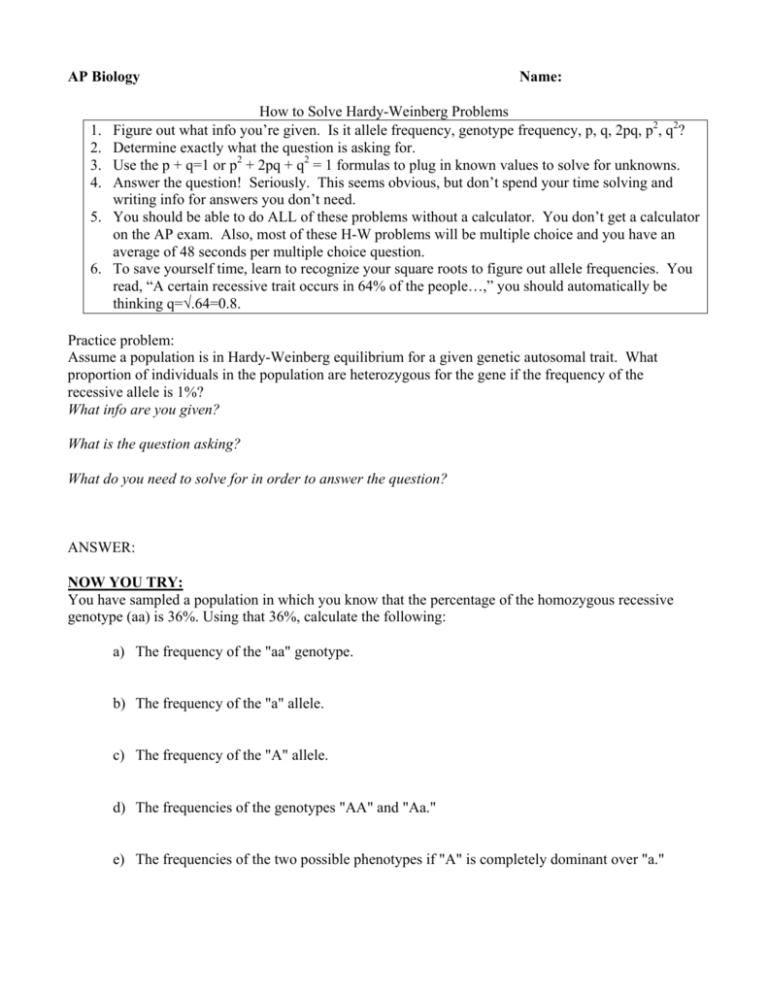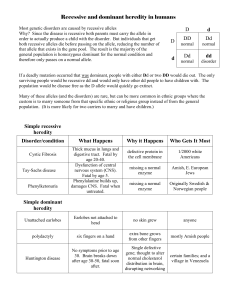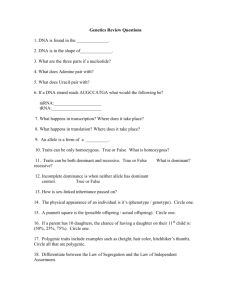AP Biology Name: How to Solve Hardy
advertisement

AP Biology Name: How to Solve Hardy-Weinberg Problems Figure out what info you’re given. Is it allele frequency, genotype frequency, p, q, 2pq, p2, q2? Determine exactly what the question is asking for. Use the p + q=1 or p2 + 2pq + q2 = 1 formulas to plug in known values to solve for unknowns. Answer the question! Seriously. This seems obvious, but don’t spend your time solving and writing info for answers you don’t need. 5. You should be able to do ALL of these problems without a calculator. You don’t get a calculator on the AP exam. Also, most of these H-W problems will be multiple choice and you have an average of 48 seconds per multiple choice question. 6. To save yourself time, learn to recognize your square roots to figure out allele frequencies. You read, “A certain recessive trait occurs in 64% of the people…,” you should automatically be thinking q=√.64=0.8. 1. 2. 3. 4. Practice problem: Assume a population is in Hardy-Weinberg equilibrium for a given genetic autosomal trait. What proportion of individuals in the population are heterozygous for the gene if the frequency of the recessive allele is 1%? What info are you given? What is the question asking? What do you need to solve for in order to answer the question? ANSWER: NOW YOU TRY: You have sampled a population in which you know that the percentage of the homozygous recessive genotype (aa) is 36%. Using that 36%, calculate the following: a) The frequency of the "aa" genotype. b) The frequency of the "a" allele. c) The frequency of the "A" allele. d) The frequencies of the genotypes "AA" and "Aa." e) The frequencies of the two possible phenotypes if "A" is completely dominant over "a." 1. Some people taste the chemical phenylthiocarbamide (PTC) as intensely bitter, while others cannot taste it at all. PTC is similar to chemicals in broccoli, Brussels sprouts, and cabbage, among other plants. Tasting PTC is a dominant trait; non-tasting is recessive. About 51% of people of European descent are tasters. If all of the assumptions of Hardy-Weinberg equilibrium are met, then among people of European descent... a) What is the frequency of the non-taster phenotype? Explain. b) What is the frequency of the homozygous recessive genotype? Explain. c) What is the frequency of the non-taster allele? Show how you determined this. d) What is the frequency of the taster allele? Show how you determined this. e) What is the frequency of each of the three genotypes? Show how you determined each one. 2. If the frequency of the dominant allele F for free-hanging earlobes is 60%, then... a) What is the frequency of the only other allele at this locus (f, which is a recessive allele for attached earlobes)? Explain. b) If all of the assumptions of Hardy-Weinberg equilibrium are met, what is the frequency of each of the three genotypes? Show how you determined each frequency. c) What fraction of the population has free-hanging earlobes? Show how you determined this. 3. Let’s say we do a study of 10,000 North Americans. At the beginning of the study, the frequency of the dominant tongue roller allele is 45%. a) After 5 generations, we find that 75% can roll their tongues. Is this population in HardyWeinberg equilibrium. Justify your answer and show the appropriate calculations below. b) Suggest a reason or scenario that might explain the situation in this question. Be creative, but try to convince me that your scenario makes sense from a genetic and evolutionary point of view. 4. There are 100 students in a class. Ninety-six did well in the course whereas four blew it totally and received a grade of F. Sorry. In the highly unlikely event that these traits are genetic rather than environmental, if these traits involve dominant and recessive alleles, and if the four (4%) represent the frequency of the homozygous recessive condition, please calculate the following: a) The frequency of the recessive allele. b) The frequency of the dominant allele. c) The frequency of heterozygous individuals. 5. Within a population of butterflies, the color brown (B) is dominant over the color white (b). And, 49% of all butterflies are white. Given this simple information, which is something that is very likely to be on an exam, calculate the following: a) The percentage of butterflies in the population that are heterozygous. b) The frequency of homozygous dominant individuals. 6. Revise these statements to follow a Darwinian explanation a) The children of body builders tend to be much more athletic, on average, than other children because the characteristics and abilities gained by their parents have been passed on to the children. b) Life arose in the aquatic environment and later invaded land. Once animals came onto land, they had to evolve effective methods of support against gravity and locomotion in order to survive. 7. What assumptions are necessary for Hardy-Weinberg equilibrium? Part II: Sexual Selection 1. What is sexual selection? How is it different than natural selection? 2. Two different bird species (species A and B) live in the same environment. In species A, there is significant sexual dimorphism between males and females. Males are slightly larger, brightly colored and sing a complex song. Females are smaller and brown colored. In species B, there is very little sexual dimorphism. Both males and females are essentially the same size and both are brown colored. a. How would Darwin explain how the males in species A came to be larger and brightly colored. b. Propose an explanation for why the level of sexual dimorphism seen in both bird species is so markedly different. 3. Say that back in 1893, a group of 1000 North American libertarians bought a large area of unpopulated jungle on the Yucatan peninsula of Mexico and moved there to establish their idea of the perfect society. They spoke no Spanish, much less Maya, so they had no relations with the few Mexicans in the region; nor did they maintain any contact with the US or anywhere else. Ten of the libertarians happened to be carriers of the sickle-cell allele. Malaria is endemic to the region. The anthropologist California Jones rediscovers the group in 2004. The population is still around 1000, all descendants of the original settlers. a) What might you expect to find has happened to the frequency of the sickle-cell allele? Explain fully. b) Dr. Jones is surprised to find that the group includes three children who are suffering from cystic fibrosis, a recessive genetic disorder that causes digestive problems, chronic lung infections, and usually death by early adulthood. Since cystic fibrosis occurs in only around 1 in 2000 births in the US population, 3 cases in a population of 1000 is unusually high. Dr. Jones has two hypotheses to explain this. The first has to do with the original settlers. Name the process he has in mind, and explain how it might have worked.








